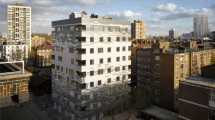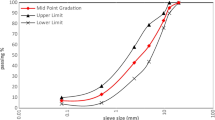Abstract
The post-fire behavior of welded connections is defined as the decrease in strength after exposure to a complete heating and cooling process. This change in strength is the key aspect for estimating the structural performance of welded connections after exposed to fire. To address this issue, this paper presents significant results of an experimental program investigating the effect of the heating and cooling process on the structural response of fillet welds subjected to different load angles. Eighteen experimental tests are carried out to examine the residual behavior of fillet welds for three different welded lap joint configurations after exposed to fire temperatures. The lap joints are categorized as longitudinal, inclined, and transverse, where the angle between the axis of the fillet weld and the direction of the applied load is 0°, 45°, and 90°, respectively. To examine the post-fire response of the three welded lap joints, the lap joints are exposed to a complete heating–cooling cycle and then loaded until failure. The post-fire tests were conducted at elevated temperatures ranging from 400°C to 900°C with 100°C increment and then cooled back to ambient temperature of 20°C prior loading. The residual responses are characterized as load–displacement characteristics after exposed to elevated temperatures. The results showed that the strength of the fillet welds for all load angles decreases as the temperature of the post-fire analysis increases. The decrease in fillet weld strength reached approximately 25%, 22%, and 27% of its initial strength for 0°, 45°, and 90° load angles, respectively, after 900°C post-fire temperature exposure. This study provides preliminary data that can support the development of design guidelines of welded connections during and after fire exposure.















Similar content being viewed by others
References
ANSI/AISC 360 (2016) Specification for structural steel buildings. American Institute of Steel Construction 360-16, Chicago
Deng K, Grondin G, and Driver R (2003) The effect of loading angle on the behavior of fillet Welds. Structural Engineering report No. 251. Department of Civil and Environmental Engineering, University of Alberta, Edmonton, Alta
El Ghor AH, Hantouche EG (2021) Rate-dependent thermal behavior of fillet welds subjected to various load Angles. Fire Saf J 122:103355
Latham DJ, and Kirby BR (1998) Elevated temperature behavior of welded joints in structural steels. Report EUR 17855 EN, European Commission—Technical Steel Research, ECSC Agreement No. 7210.SA/824
Daryan AS, Yahyai M (2009) Behaviour of welded top-seat angle connections exposed to fire. Fire Saf J 44(4):603–611
Conlon K (2009) Strength of transverse fillet welds at elevated and post-elevated temperatures. MSc Dissertation, Lehigh University.
Hanus F, Zilli G, Franssen J-M (2011) Experimental tests and analytical models for welds and grade 88 bolts under heating and subsequent cooling. J Struct Fire Eng 2(3):181–194
Ufuah E, Ikhayere J (2013) Elevated temperature mechanical properties of butt-welded connections made with high strength steel grades S355 and S460M design. Fabr Econ Metal Struct. https://doi.org/10.1007/978-3-642-36691-8_62
Liu H, Liao X, Chen Z, Huang S-S (2017) Post-fire residual mechanical properties of steel butt weld-experimental study. J Constr Steel Res 129:156–162
Zhang G, Zhu M-C, Kodur V, Li G-Q (2017) Behavior of welded connections after exposure to elevated temperature. J Constr Steel Res 130:88–95
Rezaeian A, Keshavarz M, Hajjari E (2020) Mechanical properties of steel weld at elevated temperatures. J. Constr. Steel Res. 167:105853
El Ghor AH, Hantouche EG, Morovat MA, Engelhardt MD (2020) Rate-dependent behavior of transverse welded lap joints at elevated temperatures. J Struct Eng 147(2):04020317
European Committee for Standardization (CEN) (2005) Eurocode 3: Design of Steel Structures—Part 1–8: Design of Joints and Building Frames (BS EN 1993-1-8, Brussels)
AWS (2012) Specification for carbon steel electrodes for shielded metal arc welding, AWS A5.1/A5.1M. American Welding Society. Doral, Florida
Aziz E, Kodur V (2016) Effect of temperature and cooling regime on mechanical properties of high-strength low-alloy steel. Fire Mater 40(7):926–939
Acknowledgements
The authors gratefully acknowledge the financial support provided by the American University of Beirut Research Board under Grant No. 103604-24705. Also, the authors would like to thank the National Council for Scientific Research in Lebanon and the American University of Beirut, CNRS-L/AUB, PhD award program 2019–2020 for the support of the PhD Candidate.
Author information
Authors and Affiliations
Corresponding author
Additional information
Publisher's Note
Springer Nature remains neutral with regard to jurisdictional claims in published maps and institutional affiliations.
Rights and permissions
About this article
Cite this article
El Ghor, A.H., Hantouche, E.G. Experimental Investigation on the Post-fire Behavior of Fillet Welds in the Welded Connections. Fire Technol 58, 1995–2015 (2022). https://doi.org/10.1007/s10694-022-01238-x
Received:
Accepted:
Published:
Issue Date:
DOI: https://doi.org/10.1007/s10694-022-01238-x




